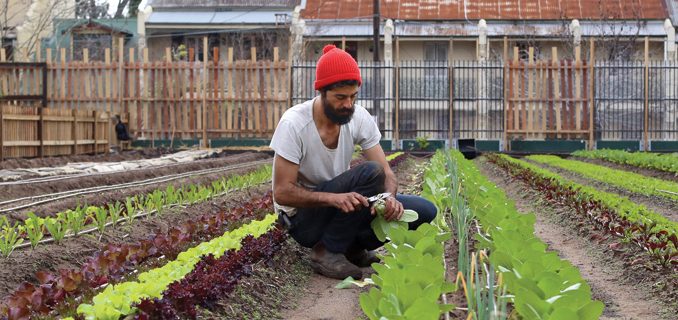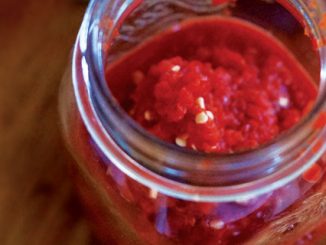
Newtown farmer, Michael Zagoridis, is one of the faces behind the urban farm that’s sprung up at Camperdown Commons, formerly the greens of the Camperdown Bowling Club. Him and his partner Emma Bowen began Pocket City Farms with the aim of greening Sydney.
What pushed you to start Pocket City Farms?
I was definitely unhappy working behind a computer desk all day and felt the need to focus my energy on something more worthwhile. My partner had just been researching urban farming projects in North America and we figured it would be worth trying something like that in Sydney. So it really just snowballed from there.
Are there any urban farming projects that you are particularly inspired by?
Initially we were blown away by Brooklyn Granges rooftop farms in New York. We went and visited them to check out their system for ourselves and came back so inspired.
How will urban farming change cities for the better?
I think urban farms have the potential to change the urban environment in so many positive ways. City dwellers will have the opportunity to engage in the food growing process without having to leave the city. From volunteers who actively want to participate and get their hands in the soil, to passive engagement from passers by who get to see the farm change as crops are sown, grown and harvested, it will build new connections between growers and consumers hopefully making people value their food more. Cities will have localised food production which helps to cut down the emissions associated with long distance food transportation. They will increase biodiversity and can help reduce the heat island effect. The additional green space improves the mental and physical wellbeing of those living in the city… I could go on and on…
What ingredients are the cornerstone of your kitchen?
Garlic, lemon and olive oil. There’s no hiding my Greek heritage I guess.
Is there any vegetable that’s surprisingly hard to grow?
One crop I have never had much luck with is capsicum. Particularly red capsicum, the fact that it stays on the plant longer to get its ‘red’ colour leaves a longer window for problems with pests and disease.
When you can’t grow your own foods, how do you choose where to buy them from?
We try to support anyone who takes their supply chain seriously and has a transparent system that aim to be a connection between growers and consumers. This includes schemes like Ooooby and The Locals Market. We also pick up staples, grains and other groceries from places like Alfalfa House and Honest to Goodness. And we love a good visit to Marrickville Markets, there’s some great growers and makers bringing their produce and fresh food there every week.
If you could turn any part of Sydney into an urban farm, where would it be and what would it produce?
I think I would have to choose Moore Park Golf Course. Location-wise it is just so close to the city. The land is really vast and could yield some serious quantities of food. We could produce seasonal produce as well as longer term perennial crops, including fruit orchards. So many possibilities on a space like that. Plus, how many people benefit from a golf course compared to the amount of people who would benefit from fresh, local food grown sustainably on your doorstep?
Springtime Toast
Slice up some asparagus longways and throw them into a cast iron pan with some garlic and olive oil.
When they start to get tender add some sliced up kale leaves, I prefer tuscan kale.
Cook them just enough to soften up. Put some sourdough on to toast and cut an avocado to spread on it.
Top with the asparagus, kale and add fresh lemon juice, salt and pepper.
Then to finish top it with some sesame seeds.
